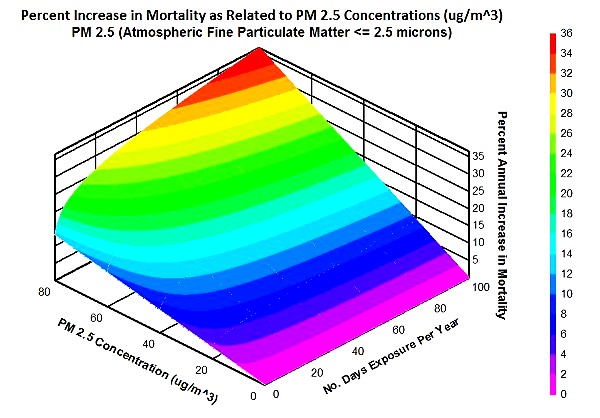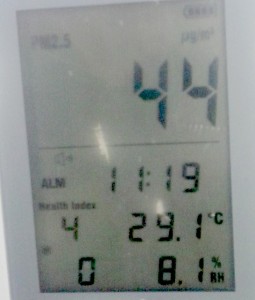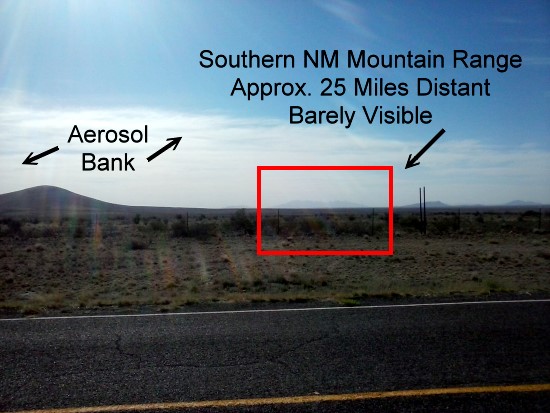Pollution, Concentration and Mortality
by Clifford E Carnicom
Mar 19 2016
A preliminary analytical model has been developed to estimate the impact of increased concentrations of atmospheric fine particulate pollution (PM 2.5) upon mortality rates. The model is a synthesis between an analysis of measured pollution levels (PM 2.5) and published increased mortality estimates. The model is based, in part, upon previous investigations as published in the paper “The Obscuration of Health Hazards : An Analysis of EPA Air Quality Standards“, Mar 2016.
Models for both concentration levels and visibility have now been developed; for a related model in terms of visibility, please see the paper entitled Pollution, Visibility and Mortality, Mar 2016.

Preliminary Concentration -Exposure – Mortality Model
A substantial data base based upon direct field measurements of atmospheric fine particulate matter in the southwestern United States during the winter of 2015-2016 has been acquired. The measurements reveal clear relationships between the quality of air, the PM 2.5 concentration levels, visibility of the surrounding territory, and the existence or absence of airborne aerosol operations.
The field data shows that repeated instances of the PM 2.5 count in the range between 30-60 ug/m3 is not unusual in combination with active atmospheric aerosol operations; visibility and health impacts are obvious under these conditions. The PM 2.5 count will inevitably be less than 10 (or even 5) ug/m3 under good quality air conditions.
Additional studies based upon this acquired data may be conducted in the future. Numerous published studies make known relationships between small increases in PM 2.5 pollution and increased mortality.
 Measured PM 2.5 Count, 44 ug/m3.
Measured PM 2.5 Count, 44 ug/m3.
As an example of use of this model, if the PM 2.5 count is 44 ug/m3 as shown in the above example, and if the number of days of exposure of this level is approximately 50, then the estimated increase in annual mortality is approximately 17%. This is an extreme increase in mortality, but under observed conditions in various locales it is not beyond the range of consideration. It is thought that reasonably conservative approaches have been adopted within the modeling process.
The field data that has been collected and this model further highlight the serious deficiencies in the current Air Quality Index (AQI) as in current use by the U.S. Environmental Protection Agency (EPA). In light of the current understanding of the health impacts of small changes in PM 2.5 counts (e.g, 10 ug/m3), a scale that gives equal prominence to values as high as 500 ug/m3 (catastrophic conditions) is an incredible disservice to the public. Please see the earlier referenced papers for a more thorough discussion of the schism between public health needs and the reporting systems that are in place.
This researcher advocates the availability of direct and real-time fine particulate matter concentration levels (PM 2.5) to the public; this information should be as readily available as current weather data is. Cost and technology are no longer major barriers to this goal.
 Active Aerosol Operation
Active Aerosol Operation
City of Rocks, Southern N.M.
 Demonstration of the Impact of Aerosol Banks Upon Visibility.
Demonstration of the Impact of Aerosol Banks Upon Visibility.
Concentration Levels and Subsequent Visibility Changes
Directly Impact Mortality.
As an incidental note, it may be recalled from earlier work that there is a strong conceptual basis for the development and application of surveillance systems that are dependent upon atmospheric aerosol concentrations. This application is only one of many that have been proposed over a period of many years, and readers may refer to additional details on this subject within the research library. Documentaries produced by this researcher (Aerosol Crimes, Cloud Cover) during the last decade also elaborate on those analyses. The principles of LIDAR apply here.
Current field observations continue to reinforce this hypothesis. Observation in the southwest U.S. indicates that two locale types appear to be preferred targets for application: these include the large urban areas and the border region between the U.S. and Mexico. These locations, considered in a joint sense, suggest that both people and the monitoring or tracking of those same people within an area may be a technical and strategic priority of the project. A citizen based systematic and sustained nationwide monitoring system of PM 2.5 concentrations over a sufficient time period can clarify this issue further.
The recent papers on the subject of air quality are intended to raise the awareness and involvement of the public with respect to environmental and health conditions. There are very real relationships between how far you can see, the concentration levels of particulates in the atmosphere, and ultimately our mortality. It is our responsibility as stewards, as well as in our own best interest, to not deliberately and wantonly contaminate the planet.
Clifford E Carnicom
Mar 19, 2016

